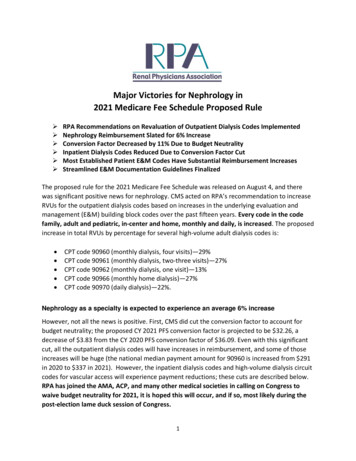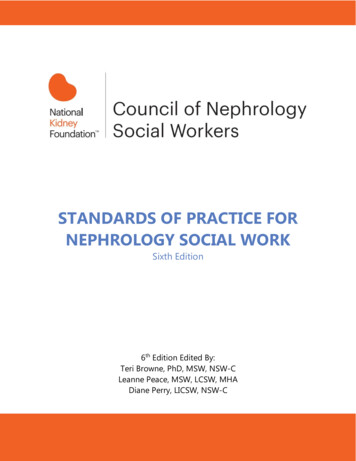
Transcription
Major Victories for Nephrology in2021 Medicare Fee Schedule Proposed Rule RPA Recommendations on Revaluation of Outpatient Dialysis Codes ImplementedNephrology Reimbursement Slated for 6% IncreaseConversion Factor Decreased by 11% Due to Budget NeutralityInpatient Dialysis Codes Reduced Due to Conversion Factor CutMost Established Patient E&M Codes Have Substantial Reimbursement IncreasesStreamlined E&M Documentation Guidelines FinalizedThe proposed rule for the 2021 Medicare Fee Schedule was released on August 4, and therewas significant positive news for nephrology. CMS acted on RPA’s recommendation to increaseRVUs for the outpatient dialysis codes based on increases in the underlying evaluation andmanagement (E&M) building block codes over the past fifteen years. Every code in the codefamily, adult and pediatric, in-center and home, monthly and daily, is increased. The proposedincrease in total RVUs by percentage for several high-volume adult dialysis codes is: CPT code 90960 (monthly dialysis, four visits)—29%CPT code 90961 (monthly dialysis, two-three visits)—27%CPT code 90962 (monthly dialysis, one visit)—13%CPT code 90966 (monthly home dialysis)—27%CPT code 90970 (daily dialysis)—22%.Nephrology as a specialty is expected to experience an average 6% increaseHowever, not all the news is positive. First, CMS did cut the conversion factor to account forbudget neutrality; the proposed CY 2021 PFS conversion factor is projected to be 32.26, adecrease of 3.83 from the CY 2020 PFS conversion factor of 36.09. Even with this significantcut, all the outpatient dialysis codes will have increases in reimbursement, and some of thoseincreases will be huge (the national median payment amount for 90960 is increased from 291in 2020 to 337 in 2021). However, the inpatient dialysis codes and high-volume dialysis circuitcodes for vascular access will experience payment reductions; these cuts are described below.RPA has joined the AMA, ACP, and many other medical societies in calling on Congress towaive budget neutrality for 2021, it is hoped this will occur, and if so, most likely during thepost-election lame duck session of Congress.1
As for telehealth, CMS does not propose to permanently waive originating site and geographicrestrictions as they do not have the authority to do so, although RPA and many other groups inorganized medicine are urging for this change to occur. CMS is proposing to create a thirdtemporary category of criteria for adding services to the list of Medicare telehealth services.Category 3 describes services added to the Medicare telehealth list during the public healthemergency (PHE) for the COVID-19 pandemic that will remain on the list through the calendaryear in which the PHE ends.This summary addresses these and other issues outlined in the proposed rule.Nephrology-Specific IssuesThe big news for nephrology in the fee schedule is the increase in value for the outpatientdialysis codes. The changes for 2021 were the result of CMS specifically soliciting comment onfamilies of services for which the values are closely tied to the values of the office/outpatientE&M visit codes (including the outpatient dialysis code family), and whether it would benecessary or beneficial to make systematic adjustments to other related fee schedule servicesto maintain relativity between these services and office/outpatient E&M visits. RPA’scomments on this point are excerpted below:As CMS knows, valuation of the monthly ESRD codes have long been based on E&Mservices. In the December 8, 1994 issue of the Federal Register setting forth the MedicareFee Schedule for 1995, then-HCFA established a process for development of work valuesfor the Monthly Capitated Payment (MCP) for ESRD services that utilized different officevisit codes as “building blocks” for the MCP. HCFA noted that the mix of the “visit codebuilding blocks most appropriately represents the typical mix of encounters with theESRD patient who is dialyzed in an ESRD facility and accounts for the service intensityand complexity of decision-making and the pre-service and post-service work for amonth’s care of a typical dialysis patient.” A panel of carrier medical directors (CMDs)that included a representative of the RUC determined that the appropriate building blockmix was four counts of the work RVUs for CPT code 99212 and two counts of the workRVUs for CPT code 99214.These values remained in place until the rulemaking cycle for the 2004 Medicare FeeSchedule, in which now-CMS established a stratified MCP payment system based on thenumber of face-to-face interactions between the MCP physician and the ESRD patient.This system established a mid-level adult MCP code (G-0318) based on the previous adultMCP code (CPT code 90921) and representing 2-3 physician-ESRD patient interactions,and provided additional RVUs for 4 physician-ESRD patient interactions (G-0317) andfewer RVUs for 1 physician-ESRD patient interaction (G-0319). This methodology wasalso applied to the pediatric series of monthly dialysis services, codes G-0308-G0310 for2
patients less than two years of age, codes G-0311-G0313 for patients between the agesof two and eleven, and codes G-0314-G0316 for patients ages twelve to nineteen.When the Five-Year Review of E&M Codes increased the work RVUs for selected E&Mcodes in 2006, the E&M value increases were applied to all global surgical packages withE&M elements. However, these increases were not applied to the family of ESRD MCPcodes. As a result, RPA petitioned CMS to apply these increases in the MCP buildingblock codes to the current MCP as part of its comments on the 2007 Medicare FeeSchedule Proposed Rule. RPA’s recommendation called for CMS to revise the ESRD MCPcodes based on the previously determined building blocks and using the mid-level code(G-0318) since that code most closely approximated the previous adult MCP code (CPTcode 90921), with the same methodology being applied to the pediatric series ofmonthly dialysis services. This recommendation was not accepted, and CMS referredRPA to the AMA Relative Value Update Committee (RUC) to determine the currentvaluation of the services associated with the ESRD MCP G-codes. The codes were valuedby the RUC in early 2008 and the values emanating from that RUC meeting form thebasis for the valuation of the monthly ESRD services in the fee schedule today.RPA believes that adjustment of the family of monthly ESRD service codes based on theincrease in underlying E&M services is long overdue. The original component buildingblocks codes for the MCP (CPT codes 99212 and 99214) have seen multiple increases invalue since the MCP was first transitioned into the RBRVS, and the subsequent increaseto global surgical packages based on E&M code revaluation since then was not appliedto the MCP code family.Such a change would also be reflective of the Administration’s appropriately increasedfocus on Advancing American Kidney Health. The nation’s chronic kidney disease (CKD)patient population continues to grow rapidly and providing nephrology practices withadditional resources to provide care to dialysis patients (only by providing increases invalue commensurate with value adjustments for their underlying building blocks) wouldbe of tremendous benefit to outpatient kidney disease care. Therefore, RPArecommends that CMS adjust the ESRD monthly service codes to reflect previousincreases in underlying E&M services.RPA has been petitioning CMS to revalue the outpatient dialysis code family based on increasesin their underlying E&M component codes that occurred several times since 2006, and haveproposed to make these changes for 2021.As for other points specifically pertaining to nephrology, the specialty impact chart included inthe proposed rule indicates that nephrology is projected to experience an estimated 6%3
increase for 2021. This places nephrology in the mid-range of impacts, with some specialtiesbeing slated for either double-digit increases, or decreases of similar magnitude.With regard to inpatient dialysis services, all four service codes (CPT codes 90935, 90937,90945, and 90947) will experience incremental increases in value for 2021, but with thereduction in the CF are proposed to have a substantial reduction in payment for 2021; forexample, CPT code 90935, hemodialysis, single evaluation, is slated to have a median nationalpayment of 67.74 for 2021, as opposed to 75.06 for 2020.On the interventional side, the large volume dialysis circuit codes will also be adversely affectedby the conversion factor reduction. CPT codes 36902 and 36905 (both balloon angioplastyservices) each have RVU increases of 7% and 8%, respectively, but because of the CF cut willexperience payment reductions of 4% and 3%, respectively.Conversion FactorAs referenced above, the proposed CY 2021 PFS conversion factor is projected to be 32.26, adecrease of 3.83 from the CY 2020 PFS conversion factor of 36.09, an approximate 11%reduction that causes the above referenced double-digit decreases in yearly impacts for somespecialties and subspecialties resulting from Congressionally mandated budget neutrality. Fornow, the CF cut will be required in 2021 to offset the payment increases for office visits andother services (including the dialysis code family). This has been an issue especially forprocedurally based societies since its rollout in 2019 and there will be intense lobbying to waivebudget neutrality before year’s end; RPA will be supporting these efforts.Evaluation and Management (E&M) ServicesThe value increases for evaluation and management services first proposed in the 2020 rulehave in essence been finalized, so all E&M codes will have RVU increases. However, this isanother area where the CF cuts reduce or even eliminate the RVU gains. Most of the newpatient office visit codes (CPT codes 99202-99204) will have reimbursement decreases whenthe RVUs and the CF have been accounted for, while 99205 will have a modest 0.4% increasefor 2021. Much more positive news is on the established patient E&M side, where the onlycode experiencing a reimbursement hit is 99211 (-3.5%), while all of the other establishedpatient codes have reimbursement increases, all sizable. These increases are noted below: CPT code 99212 (level two office visit)—18% increaseCPT code 99213 (level three office visit)—15% increaseCPT code 99214 (level four office visit)—11% increaseCPT code 99215 (level five office visit)—16% increase4
The established patient E&M code reimbursement increases would presumably besubstantially beneficial in the treatment of persons with chronic kidney disease (CKD).CMS proposes to implement finalized CPT descriptors, guidelines, and payment rates onJanuary 1, 2021, which will be a significant modification to the coding, documentation, andpayment of E&M services for office visits. Additionally, positive news in the proposed rulepertains to reduction of E&M documentation burden. As part of the proposed rule for 2020,CMS has indicated that for 2021: (1) the arbitrary “bullet-point” methodology of documentingE&M services will be discontinued (CMS referred to this in last year’s rulemaking cycle as“clinically outdated”), and the level of billing will be determined by either medical decisionmaking or time; (2) regarding history and physical documentation, it only needs to reflect whatis medically appropriate; and (3) if the clinician bases the billing level on time, it will include“the total time personally spent by the reporting practitioner on the day of the visit (includingface-to-face and non-face-to-face time)” so time prior to or after the face-to-face interactionwith the patient can be included.TelehealthWhile it was anticipated that there might be big news in the area of telehealth in this proposedrule (based on statements by CMS Administrator Seema Verma, among others) major changesdid not seem to occur. The Agency does propose adding several codes to the permanenttelehealth list, including for prolonged services and home visits. Additionally, CMS addressesthe issue of audio-only interactions as follows:In the March 31st COVID-19 IFC, we established separate payment for audio-onlytelephone evaluation and management services. While we are not proposing to continueto recognize these codes for payment under the PFS in the absence of the PHE for theCOVID-19 pandemic, the need for audio-only interactions could remain as beneficiariescontinue to try to avoid sources of potential infection, such as a doctor’s office. We areseeking comment on whether CMS should develop coding and payment for a servicesimilar to the virtual check-in but for a longer unit of time and subsequently with ahigher value. We are seeking input from the public on the duration of the services andthe resources in both work and practice expense associated with furnishing this service.We are seeking comment on whether this should be a provisional policy to remain ineffect until a year after the end of the PHE for the COVID-19 pandemic or if it should bePFS payment policy permanently.RPA is finalizing recommendations for the use of telehealth in kidney care and will be providethat document to senior staff at the Department of Health and Human Services (HHS), CMS,and on Capitol Hill.5
Medicare Diabetes Prevention Program (MDPP)Although CMS has permitted many MDPP services to be provided virtually during the COVID-19public health emergency, it still requires the first core session to be provided in-person, whichprevents any new patients from participating. The proposed rule would drop that requirementand allow all MDPP services to be delivered virtually during the current emergency as well as infuture declared emergencies. CMS also proposes to allow patients to report their weightthrough virtual means, such as Bluetooth scales. The proposed rule stops short of allowingproviders of virtual-only DPP services to enroll as MDPP suppliers, however.SummaryThis is a complex fee schedule rule even by the standards of previous Medicare Fee Schedules.RPA will continue to analyze the rule’s proposals to discern any further meaningful impact onnephrology practices. RPA will also continue to advocate for the waiving of budget neutrality inthe conversion factor throughout the fall, both as an individual organization and within thecontext of coalitions. Comments on the proposed rule will be submitted to CMS on or aroundOctober 4, 2020. RPA’s comments will be posted at www.renalmd.org after that date.6
CPT code 90962 (monthly dialysis, one visit) —13% CPT code 90966 (monthly home dialysis)—27% CPT code 90970 (daily dialysis) —22%. Nephrology as a specialty is expected to experience an average 6% increase . However, not all the news is positive. First, CMS did cut the conversion factor to account for










